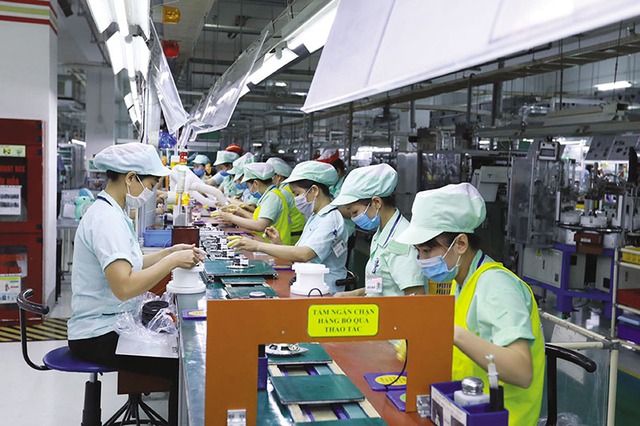Vietnam can become a leader in the semiconductor industry
VTV.vn – From now on, millions, if not billions, of chips will be manufactured in Vietnam as the global semiconductor supply chain shift is heading towards new markets.
Semiconductor chips are ubiquitous
During President Joe Biden’s visit, leading global chip manufacturers such as Intel, Marvell, Amkor, and others came and discussed collaboration in developing the semiconductor industry with Vietnamese technology companies. This is seen as a significant opportunity for Vietnamese businesses to enter this trillion-dollar market.
RAM, an indispensable component in computers, plays a vital role. On the circuit board are tiny chips, no larger than a fingernail. A single computer may contain hundreds of such chips, all made from semiconductor materials, but each with its own specific function: processing, computing information, or storing data.
These chips serve as the brains of devices and are therefore crucial components in electronic devices. In some devices like smartphones, despite their small size, chips can account for up to 30% of the device’s value.

Just a few years ago, almost all of these chips had to be imported, but from now on, there will be millions, if not billions, of chips manufactured in Vietnam as the global semiconductor supply chain shift is heading towards new markets.
The Shift in the Semiconductor Supply Chain
With abundant resources, the United States and Europe have introduced attractive incentive programs to attract semiconductor companies to expand their investment in manufacturing. Among these initiatives, Taiwan’s TSMC (China) has invested billions of dollars in a factory project in the state of Arizona while simultaneously developing its first semiconductor plant in Europe.
“In Europe, we are very interested in TSMC’s investment project. We hope to expand chip production activities in Europe,” said Bettina Stark Watzinger, Germany’s Minister of Education and Research.
In Asia, Micron and Foxconn are planning investments in India, while GlobalFoundries, the world’s third-largest contract chip manufacturer, recently inaugurated a $4 billion factory in Singapore.
“The global economy faces many challenges, but we believe that the semiconductor industry will still double in the next decade. The driving force for this growth is artificial intelligence (AI),” noted Thomas Caulfield, CEO and Chairman of GlobalFoundries.
“Perhaps Singapore cannot yet enter the high-end chip manufacturing sector. However, for certain specialized chips, we still have a competitive edge, and we will enhance our capabilities in this field. The investment commitments from chip manufacturers demonstrate the effectiveness of our strategy,” stated Lawrence Wong, Deputy Prime Minister and Minister for Finance of Singapore.
Vietnam Accounts for 10% of Chip Imports into the US
Vietnam now accounts for over 10% of the chip imports into the United States, and in terms of revenue, it ranks third in Asia, after Malaysia and Taiwan (China), in semiconductor chip exports to this market.
Notably, there are chips that are 100% Vietnamese-owned, from design to final stages of production. Most importantly, they are manufactured right in Vietnam. 70 million such chips have already appeared in smart devices worldwide.
Vietnam Can Lead the Semiconductor Industry
Truong Gia Binh, Chairman of FPT Group, stated, “70 million chips have been ordered by South Korea, Japan, and Taiwan. The chips we have developed are 100%. When we become a global chip center, our opportunities will be boundless. This is a great hope for the country. How do we rise? How does Vietnam prosper? Science and technology are the shortest paths that we have proven we can succeed in the software field.”
Regarding the evaluations that technology conglomerates producing chips worldwide are turning to Vietnam because of the country’s substantial rare land reserves, Truong Gia Binh said that Japan used to buy sand from Vietnam for making glass discs, but this was not significant or decisive. “The issue is how we provide human resources, what value we bring to them. Before, we had to go abroad for software, but now we produce chips right here in Vietnam,” he emphasized.
Developing High-Quality Human Resources for the Electronics and Semiconductor Industry
To seize this opportunity, one of the top priorities remains high-quality human resources.
According to the Semiconductor Industry Association of the United States, it is projected that the shortage of semiconductor engineers, technicians, and computer scientists in the industry will reach 67,000 workers by 2030. With the demand for the development of smart devices and artificial intelligence requiring an increasingly large supply of chips, Vietnam can seize this opportunity with its abundant human resources.
To produce a complete chip, it goes through three main stages: design, manufacturing, and testing and packaging. Among these, the design stage accounts for about 50-60% of the product’s cost, the manufacturing stage accounts for about 25-30%, and the remaining testing and packaging stage accounts for about 15-20%.
The Electronics and Semiconductor Training Center was established with the crucial mission of training high-quality human resources to meet the needs of this industry. It serves as a foundation to attract investment, international cooperation, and major international investors, meeting the needs of domestic enterprises.
The government of Ho Chi Minh City revealed that, with a newly launched resolution, the city will boldly experiment with developing a high-tech science and technology zone with the main focus on the electronic chip sector.
“Based on cooperation with Synopsis Group, a provider of semiconductor design tools from the United States, our goal is to create startups in semiconductor design, which will absorb human resources in the semiconductor field,” said Nguyen Anh Thi, Head of the Management Board of High-tech Development in Ho Chi Minh City.
According to statistics from the Vietnam Microelectronic Community, there are currently about 5,500 chip design engineers nationwide, mainly in Ho Chi Minh City (85%), Hanoi (8%), and Da Nang (7%). The goal by 2030 is for the Ho Chi Minh City Electronics and Semiconductor Training Center to train over 50,000 semiconductor design engineers.
Refer to the original post here
For additional details, refer to our SIA services | Link



